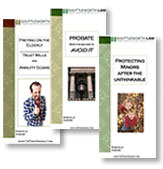Trust Basics
A trust relationship in the legal sense is a relatively simply concept. One person gives property to another person or entity who agrees to hold the property. The one giving the property is the trustor (also known as “grantor” or ”settlor” and the one who holds the property is the “trustee”. The beneficiary is the one who is entitled to use the property during the trust relationship or receives the property when the trust relationship stops.
A very simple example of a Trust relationship could be as follows: You say to your friend, “Please hold on to my wallet while I go for a swim”, and the friend replies “OK. Don ‘t worry, I’ll take good care of it”. Here, the trustor is you and the trustee is your friend and once he or she returns the wallet as agreed, the trust relationship ends.
Same example, but this time you add, “ and if I don’t’ come back within an hour, give my wallet to my spouse or give her some money to buy some snacks”. Your friend again agrees to do so. You are still the trustor, your friend is the trustee and your spouse is the beneficiary of the trust assets (your wallet or money) if you don’t come back.
NOTE: This website is for general information only. No attorney-client relationship is established by the use of this website and use of this website is strictly conditioned upon the Site User Agreement.

